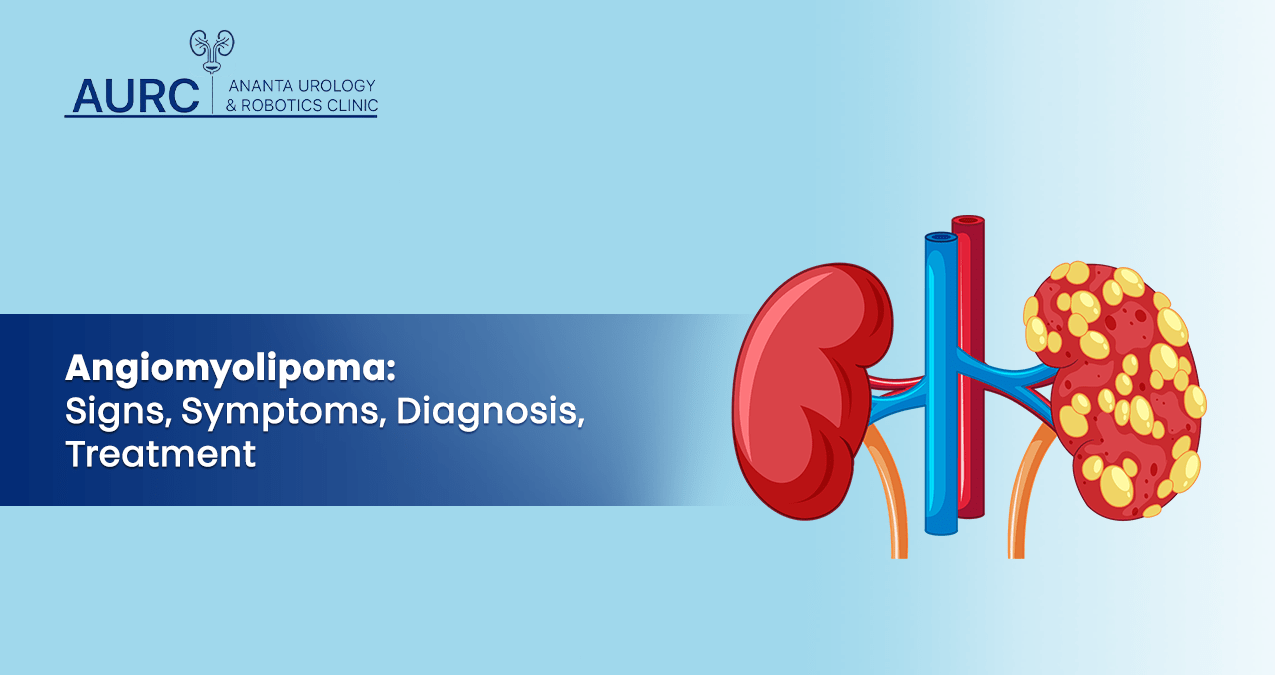Angiomyolipoma: Signs, Symptoms, Diagnosis, Treatment

Table of Content:
- What is an Angiomyolipoma?
- Characteristics of Angiomyolipomas in the Kidney
- Types of Angiomyolipomas
- Causes and Risk Factors
- Symptoms of Angiomyolipoma
- Diagnosing Angiomyolipoma
- Treatment Options for Angiomyolipoma
- Preventing Angiomyolipoma Complications
- Conclusion
What is an Angiomyolipoma?
Angiomyolipomas are rare, non-cancerous kidney tumours that develop from an unusual combination of fat, blood vessels, and smooth muscle cells. While typically benign, these tumours can sometimes grow large, leading to complications such as massive bleeding or impaired kidney function.

Characteristics of Angiomyolipomas in the Kidney:
Non-cancerous but can cause health issues.
Usually unilateral (affecting one kidney), but can occasionally occur in both kidneys, especially in patients with tuberous sclerosis complex (TSC).
Classified based on their fat content and clinical presentation.
Types of Angiomyolipomas:
Classic Angiomyolipoma: Contains visible fat and is easier to diagnose using imaging techniques like CT or MRI.
Fat-Poor or Minimal-Fat Angiomyolipoma: Lacks significant fat, making diagnosis challenging as it can mimic malignant kidney tumours.
Understanding these subtypes is critical for accurate diagnosis and appropriate treatment.
Causes and Risk Factors
Angiomyolipomas are either sporadic or associated with genetic conditions in patients. Understanding the underlying cause is vital for effective management.
Causes:
Tuberous Sclerosis Complex (TSC):
A genetic disorder caused by mutations in the TSC1 or TSC2 genes.
Leads to the growth of benign tumours in multiple organs, including the kidneys.
Nearly 80% of individuals with TSC develop angiomyolipomas.
Sporadic Angiomyolipomas
These occur without any genetic predisposition and are more common in women between 40 and 60.
Risk Factors:
Hormonal Influences: Estrogen and progesterone can promote tumour growth, making pregnancy a high-risk period for complications.
Age and Gender: Middle-aged women are at the highest risk due to hormonal factors.
Genetics: Inherited conditions like TSC increase susceptibility.
Contact the best urologist in Ahmedabad to learn if you have risk factors for Angiomyolipoma.
Symptoms of Angiomyolipoma
While many angiomyolipomas remain asymptomatic, larger tumours or those that rupture can cause severe symptoms.
Common Symptoms:
Flank Pain: Persistent or intermittent pain in the back or side, often due to tumour growth or bleeding.
Hematuria: Visible or microscopic blood in the urine occurs when the tumour invades blood vessels.
Abdominal Mass: A palpable lump can sometimes be felt in the abdomen or flank.
Fatigue or Weakness: Often a result of anaemia caused by internal bleeding.
Sudden Shock or Hypotension: Rare but serious. This can occur if a tumour ruptures, leading to life-threatening blood loss.
Early detection of symptoms and prompt medical attention from the kidney cancer specialist in Ahmedabad are crucial to prevent severe complications.
Diagnosing Angiomyolipoma
Accurate diagnosis is the cornerstone of effective management. Angiomyolipomas need to be differentiated from cancerous kidney tumours to avoid unnecessary treatments.
Diagnostic Tests:
Ultrasound:
A first-line imaging tool that can detect fat-rich angiomyolipomas as echogenic (bright) lesions.
Advantages: Non-invasive, cost-effective, and readily available.
CT Scan (Computed Tomography):
Provides detailed images to confirm the presence of fat in the tumour.
Particularly useful for identifying classic angiomyolipomas.
MRI (Magnetic Resonance Imaging):
The preferred modality for fat-poor angiomyolipomas.
It offers superior contrast resolution, making distinguishing benign from malignant lesions easier.
Biopsy:
Rarely required but may be performed when imaging results are inconclusive.
Involves extracting a small tissue sample for histopathological examination.
Why Early Diagnosis Matters:
Timely identification can prevent complications, reduce the risk of kidney cancer damage, and guide appropriate treatment decisions.
Contact the top urology hospital in Ahmedabad to learn about treatment options if you have been diagnosed with Angiomyolipoma.
Treatment Options for Angiomyolipoma
The management of angiomyolipomas depends on their size, symptoms, and potential for complications. Treatment aims to alleviate symptoms, prevent rupture, and preserve kidney function.
Active Surveillance:
When Recommended:
Small tumours (<4 cm) that are asymptomatic and show no signs of rapid growth.
What it Involves:
Regular imaging (ultrasound, CT, or MRI) every 6–12 months to monitor tumour progression.
Routine blood and urine tests to assess kidney function.
Advantages:
Avoids unnecessary interventions.
Minimizes risks associated with surgery or invasive procedures.
Medications:
mTOR Inhibitors (e.g., Everolimus):
Particularly effective in TSC-associated angiomyolipomas.
Mechanism: Inhibits the mTOR pathway, which is hyperactive in TSC, reducing tumour size and preventing growth.
Side Effects: Mild gastrointestinal symptoms, fatigue, and mouth ulcers.
Minimally Invasive Procedures:
Embolization:
A catheter-based procedure blocks the blood supply to the tumour, causing it to shrink.
Ideal For: Tumors causing bleeding or at risk of rupture.
Benefits:
Minimally invasive.
Quick recovery time (1–2 days).
Risks: Minor post-procedure discomfort or transient fever.
Surgical Interventions:
Partial Nephrectomy:
Removes only the tumour while preserving healthy kidney tissue.
Preferred For:
Large angiomyolipomas (>4 cm).
Tumours causing recurrent symptoms or impairing kidney function.
Advantages:
Maximizes kidney preservation.
Low recurrence rates.
Radical Nephrectomy:
Complete removal of the affected kidney.
Reserved for cases where the kidney is severely damaged or if the tumour cannot be safely removed while preserving kidney function.
Thermal Ablation:
Uses techniques like radiofrequency or cryoablation to destroy tumour tissue.
Advantages:
Minimal downtime.
Ideal for patients unfit for surgery.
Contact Ananta Urology & Robotics Clinic, the best urology surgeon in Ahmedabad, for expert treatment options or a second opinion on your Angiomyolipoma.
Preventing Angiomyolipoma Complications
Preventive measures are vital to reduce the risk of bleeding or rupture, especially in high-risk patients.
Prevention Tips:
Regular Monitoring: Annual imaging and kidney function tests for individuals with a history of angiomyolipomas or TSC.
Maintain a Healthy Lifestyle:
Stay hydrated to support kidney health.
Follow a low-salt diet to reduce kidney strain.
Avoid Risky Activities: High-impact sports or activities that may cause abdominal trauma should be avoided.
Special Considerations for Pregnancy: Hormonal changes during pregnancy can accelerate tumour growth. Pregnant women with angiomyolipomas should undergo close monitoring.
Conclusion
Angiomyolipomas, though benign, can pose significant health risks if left untreated. Understanding their symptoms, diagnosis, and early consultation with Dr. Rohan Patel for treatment options is essential for effective management.

